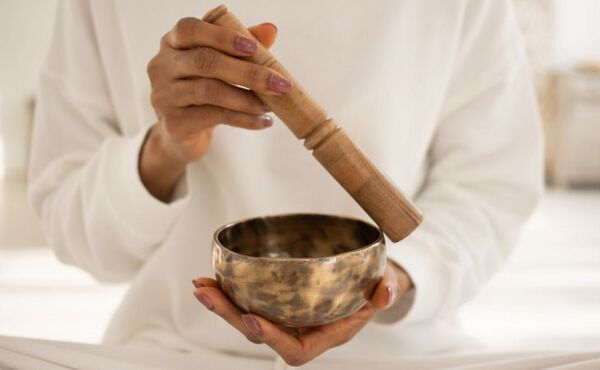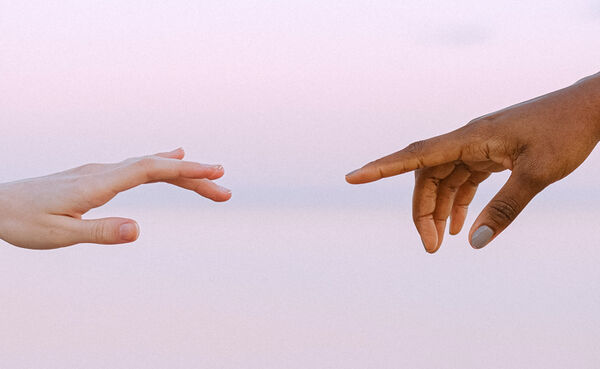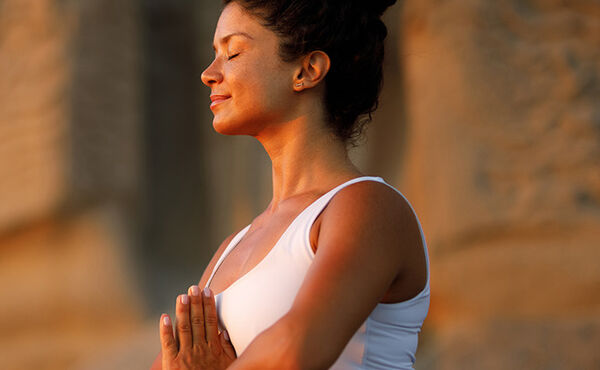Discover practical ways to begin your meditation journey with our ultimate how to meditate guide.
Former Yahoo executive-turned-LinkedIn CEO Jeff Weiner, founder of Huffington Post Arianna Huffington and multi-hyphenate Oprah Winfrey, to name a few, all lean on meditation. And the science speaks for itself, meditation has been proven time and again to support overall wellbeing. Meditation reduces cortisol levels in the body, decreases anxiety levels, promotes emotional health, improves sleep and can even help you control pain.
But, as with so many wellbeing trends, there is so much information and opinion about how to do it right. So, we have cut through the noise and created an ultimate guide to how to meditate. Keep scrolling to discover everything you need to know to meditate right.
WHAT IS MEDITATION?
Simply put, meditation is the practice of training your awareness with moments of focused attention. There are various different ways to meditate and the key to your meditation success is finding the right method for you.
WHAT ARE THE ORIGINS OF MEDITATION?
The word meditatum derives from a Latin term that translates to ‘to ponder’. Nobody quite knows the exact time in which meditation originated, in China, the earliest forms date back as far as 6th century B.C. According to Indian sources, meditation practice began in 500 B.C. with the Hindu practice of Dhyāna or Jhāna, which are both referenced to as the training of the mind. As the practice evolved, meditation became a way of life with the teachings of the Indian Buddha, a prince turned religious monk, Chinese “wisdom of silence” master and philosopher Lao-Tze and Japanese, Dosho, a 7th-century monk who taught the sitting mediation and coined the term ‘zen’.
ARE MEDITATION AND MINDFULNESS THE SAME THING?
To be mindful is simply to be aware of what is around you and to be present. This is an intention which we can all incorporate into our daily lives. Meditation, on the other hand, is a practice.
There is such a thing as mindful meditation, where the two collide. This is a formal practice where you set aside time to focus on what is right in front of you, with the intention to be genuinely present. In this way, you cannot think ahead or look backwards; instead, you focus on being right here, right now.
HOW DO YOU KNOW MEDITATION IS WORKING?
We have a few sure-fire signs to help you know that your meditation practice is working:
- You forgot you were meditating, finding yourself lured into a calm state.
- You experienced a time lapse whereby you mediated for 30 minutes, but it felt like 10.
- Your body felt completely relaxed as you drifted off into blissful unawareness.
WHAT ARE THE DIFFERENT TYPES OF MEDITATION AND WHICH IS BEST FOR ME?
There are various different types of meditation practice and finding the best method for you is the key to finding something that works for you and that you can do consistently.
Below you can discover the different types of meditation practices:
Body Scan Meditation
iis exactly that. You meditate while mindfully scanning your body focusing on your head, the muscles in your face, relaxing your eyes, your lips, your tongue. You continue focusing on and relaxing every single part of your body. This is a great wat to start meditating, as it helps you reach a restful state. Try our guided body scan meditation here.
Mindfulness Meditation
is all about focusing on being in the moment and can be applied to everyday living. For example, when brushing your teeth or commuting to work, you can practice mindful meditation. Either by focusing deeply on the task at hand – the colour of the toothpaste, texture of the brush – or by your surroundings, perhaps you decide to take a new route to work or you take the same route but challenge yourself to see new things on the way.
This type of meditation is particularly good to lean on during moments of anxiety. Mindful meditation reduces stressors in the body, particularly in a part of the brain called the amygdala making it easier to bounce back from stress.
If you are looking for mindful mediations to incorporate into your every day, discover our self-love mirror meditation or embrace mindful meditation when commuting to work with our happiness top-up walking meditation.
Mantra Meditation
This type of meditation is where you repeat a mantra over and over, letting any thoughts pass you by like clouds in the sky. If you become distracted by your thoughts you simply and kindly bring your attention back to your mantra. This form of mediation is all-encompassing and can benefit brain function, reduce stress and anxiety and even improve cardiovascular health.
Visualisation Meditation
is a powerful tool you can access anytime and anywhere. When times are tough, visualising your goals and dreams puts your energy towards positivity.
Gaining popularity in the 1980s, Russian athletes used visualisation as a way of improving their abilities before the Olympics. Today, visualising a positive end result is used by athletes, successful entrepreneurs and even politicians as a way of manifesting and subsequently reach their desired goal.
When practising visualisation, our brains can struggle to distinguish between what is fantasy versus what is reality which can, over time, help to make that dream a reality. This mediation practice is perfect for improving focus, ability and performance, so you can push forward and reach your goals. It has even been proven to decrease the frequency of migraines.
Want to try? Discover a visualisation meditation that will reset your outlook on life and give you practical techniques to embrace the power of visualisation.
How To Meditate For Beginners
“Before you begin, just remind yourself that there is no way to get this wrong or mess up, don't compare your meditation practice to anyone else and just give yourself some grace,” says expert Giselle La Pompe-Moore. “You might struggle to focus, want to roll your eyes, get distracted or fidget, and that is all perfectly okay. It's always a good idea to find guided meditation recordings from a trusted and qualified practitioner so you feel safe and reassured”.
With this in mind, try Giselle’s latest guided meditation she created for Rituals.
How To Meditate Correctly
While there is no right or wrong way to do meditate, here are some best practices that will set you up for success.
1. Find your comfy spot.
“Everyone's body is different, and we all find certain positions more comfortable than others, so trust yourself and don't push through discomfort for the sake of it,” says Giselle.
“You can try out a few positions. You can sit upright on a chair with your feet planted on the ground. This is great if you're just starting out, as we aim for a state of rested awareness, so you're feeling relaxed but still able to follow your practice. Lying down on a comfortable surface or in bed is another position, but if you find yourself drifting off (which is normal), you might want to practice in a seated position for a while first.
“You can also sit cross-legged on the floor, which is not doable for everyone or even kneeling down with your palms in your lap. Release any do's and don'ts, and as long as your spine is nice and aligned, see what works for you and your body,” adds Giselle.
2. Be kind to your wandering mind.
“Don't try to control your thoughts. Let them in!” says Giselle. “You're a human being, you're going to think, and thinking is more than okay. Don't judge your thoughts. Let them in and shift it to whichever anchor you're using in your practice when a thought comes.”
That anchor could be your mantra, your body part, the chore you are trying to mindfully execute, or whatever you were visualising.
“That's all that meditation is. You have a thought and then you bring your focus back. You do this repeatedly, and with practice and gentleness, you will find yourself out of thought and into the present moment for longer periods”, explains Giselle.
3. Avoid set times for meditation.
With transcendental meditation, it is recommended that you do 20 minutes in the morning and 20 minutes in the afternoon but that’s not practical for everyone, so when you’re starting out do what you can.
“The wonderful thing about meditation is that your practice is exactly that; it is yours,” says Giselle. “If you have a hectic morning routine, adding meditation to the mix may make you feel more at peace, but if it just makes you feel even more stressed, then do it when you have more space.
“Whether you can do a short 1-5 minute practice on your lunch break or spend a little longer after you've watched TV in the evening, the most important thing is that you do it when and however feels good to you. If you're trying to build a habit, doing it every day can help, but work with how you feel and how much room you have so it feels enjoyable instead of an obligation,” notes Giselle.
4. Focus on your breathing.
A simple yet effective tip is to breathe through your nose, with your mouth closed, focusing on the air moving in and out of your nostrils and enlarging your lungs, noticing the rise and fall of your belly.
For a quick stress-relieving breathing exercise, discover our expert guided meditation with breathwork as the focus.

Can You Meditate With Music?
Music has long been linked to wellbeing and can instantly change the mood of a room or the thoughts and feelings of a person's mental state.
Music has the ability to impact cognitive performance, improve memory, and can even help you lose weight. With this in mind, there are health benefits to listening to music, but can music also be used as an accompaniment when meditating? The answer is yes and no.
For mantra meditation and meditations that focus on breathwork, music can distract. However, music can aid mindful or visualisation meditation and help draw you into a meditative state.
Read all about our Rituals Spotify Playlists here.
Getting The Most Out Of Meditating
At the start of your meditation journey, it can be frustrating. Both fitting it in and reaching a meditative state can be challenging.
Sitting with your mind requires dedication, patience and most of all stamina to get through those feelings of restlessness and boredom. Below, you can find some quick tips on when and how you can implement meditation into your life and stick with it.
How Often Should You Meditate?
Mediation can ultimately be practised at anytime and anywhere, but as the saying goes, practice makes perfect, and this can be applied to meditation. Giselle notes how “consistent practice is great for creating a habit and to feel more of the benefits from meditation, see what feels good as you define what 'consistent' is, this might be daily or every other day”.
How Long Should I Meditate?
As a beginner, you should start out with five minutes of meditating daily. Studies have found this will help you snap out of feelings such as rumination and overthinking and, over time, you’ll reap the benefits.
However, the optimal time for meditating is between 10-20 minutes per day, with a study in 2008 finding as little as 13 minutes per day had a significant impact on the overall wellbeing. It’s important to remember that meditative practice is subjective, so what works for one person might not work for another. Finding your groove and picking a meditation length that will ultimately create consistency is key here. If you have a busy life, picking a guided walking meditation might be the perfect way to start.
When Is The Best Time To Meditate?
Again there is no right and wrong answer, some of us have extremely busy lives, while others travel often, and for some, night-shift work is routine. Therefore, the time you choose to meditate during your day is very much based on you and your schedule. As long as it can be slotted into your daily routine then you will reap the benefits of meditating.
We only have a finite amount of willpower per day, so if you find yourself skipping your evening meditation then try to aim for a morning session. Setting your intention for the day with meditation can help you invite gratitude, awareness and positivity into your life. According to studies it reduces cortisol in the body before any real-life stressors have even occurred and can even help you cope better when they do.
How To Start Meditating Daily?
"Just begin as you are,” says Giselle. “Even if you're uncertain, all you have to do is show up, find a guided meditation to follow along with and release any expectations or rules,” says Gieselle.
You can discover a free selection of meditations created by Giselle for Rituals here. They have been made with beginner's needs in mind and are the perfect length to slot into your daily routine.
5 Beginner Meditations To Try
Your beginner’s guide to meditation.
Meditation made easy with our expert.
Explore this easy guided meditation.
Our simplest ever beginner’s meditation.
This 1-minute meditation is like hitting reset in your mind.
Below, shop our meditation starter kit for all your go-to accessories and essentials.







